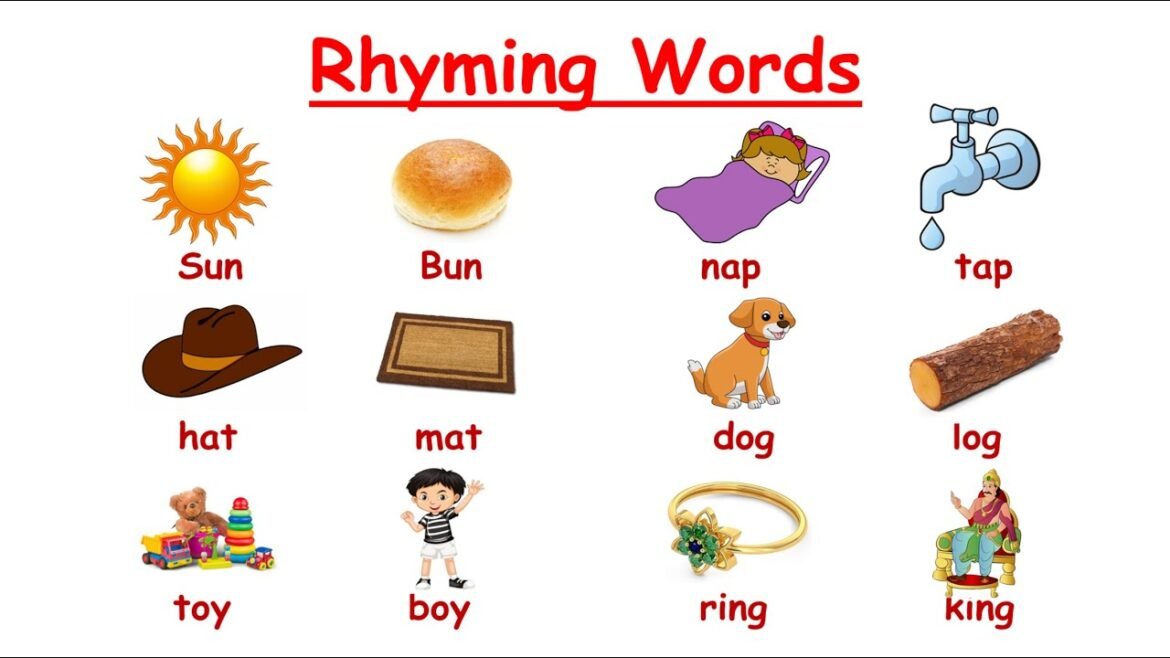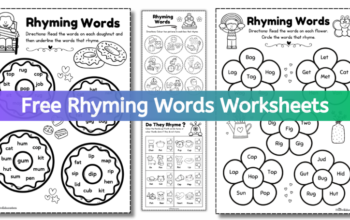Rhyming words are a crucial part of early language learning. They help children develop important skills like reading, pronunciation, and memorization. By working with rhyming words, students also gain phonemic awareness, which is the ability to hear and manipulate sounds in words. This awareness is foundational for learning to read and write effectively. Worksheets designed around rhyming words provide an engaging way to reinforce these skills. In this article, we will explore what rhyming words are, the benefits of learning them, how worksheets can help, and where to find free rhyming words worksheets for students.
What Are Rhyming Words?
Rhyming words are words that have the same ending sound, such as “cat” and “hat,” “ball” and “wall,” or “book” and “look.” They are often used in poetry and songs, making them fun to learn. The ability to recognize rhyming words helps children develop their listening and speaking skills. When children can identify rhyming words, they are also building a foundation for phonics, which is the connection between letters and their sounds. Phonics helps students decode words when they are reading, making rhyming words a key element in early literacy development.
In addition, rhyming words allow children to play with language. By hearing and repeating rhymes, they become more comfortable with the sounds of words, which makes reading easier. Recognizing rhyming patterns also helps children predict how words might be spelled or how they might sound in different contexts, supporting both reading fluency and writing skills.
Benefits of Learning Rhyming Words
Learning rhyming words offers many benefits to students, particularly in their early education. One of the biggest advantages is the improvement in reading and pronunciation. When children recognize rhyming patterns, they become more confident in their ability to read and pronounce words. This is especially helpful for beginning readers who may struggle with unfamiliar words. Rhyming words act as a helpful tool, allowing children to rely on their knowledge of word families (like “-at” in cat, hat, and bat) to read new words.
Another important benefit of learning rhyming words is the development of memory and recognition skills. Rhymes are easier to remember than non-rhyming words, so children often remember rhyming words more easily. This makes it easier for them to expand their vocabulary as they grow and learn new words. Rhyming words also enhance a child’s ability to distinguish sounds in words, which is known as phonemic awareness. Phonemic awareness is vital because it helps children with both reading and writing.
Rhyming words also play a significant role in building creativity and imagination. When children listen to rhymes in songs, poems, or stories, they begin to see language in a fun and playful way. This fosters a love of language that can last a lifetime.
How Rhyming Words Worksheets Can Help
Rhyming words worksheets are an excellent way to engage students in learning while providing structure to their practice. These worksheets often include activities such as matching rhyming words, filling in missing words to complete rhymes, and identifying rhyming patterns in a group of words. By completing these exercises, students can develop a deeper understanding of how rhymes work, which will support their overall language development.
Worksheets can also help track students’ progress over time. For instance, teachers can review a student’s completed worksheets to see which rhyming words they are mastering and where they may need additional practice. This is particularly helpful in classrooms where teachers are working with multiple students of varying skill levels. Worksheets allow teachers to tailor learning to each child’s needs, providing extra practice or introducing new concepts as needed.
Additionally, worksheets provide a hands-on approach to learning. Unlike passive activities like listening to a story, worksheets require students to actively participate, reinforcing the learning experience. The interactive nature of worksheets encourages critical thinking, problem-solving, and independent learning, all of which are essential skills for academic success.
Free Rhyming Words Worksheets for Students
Finding high-quality, Rhyming words worksheet free is easy, thanks to the abundance of online resources. Many educational websites offer printable worksheets that focus on rhyming words. These worksheets come in a variety of formats, including puzzles, games, and exercises, to keep students engaged and motivated. Parents and teachers can simply search for “free rhyming words worksheets” to find numerous options that are ready to print and use.
Free worksheets are a valuable resource because they allow parents and teachers to support their children’s learning without having to purchase expensive educational materials. These worksheets can be used both at home and in the classroom, making them a versatile tool for reinforcing language skills. Some websites even offer customizable worksheets, where teachers can adjust the difficulty level or focus on specific types of rhyming patterns to meet the needs of individual students.
In addition to printable worksheets, many online platforms provide interactive worksheets that students can complete on computers or tablets. These digital worksheets can be particularly engaging for tech-savvy students, adding an extra layer of fun to the learning process. With so many free resources available, parents and teachers have a wealth of options to help students improve their rhyming skills.
Examples of Rhyming Word Activities
Rhyming word activities can be both educational and fun, making them ideal for engaging young learners. One simple activity is to have students match rhyming words. For example, students can be given a set of words, such as “dog,” “log,” “bat,” and “rat,” and asked to pair the rhyming words together. This activity helps students recognize rhyming patterns while reinforcing vocabulary.
Another fun activity is the “fill-in-the-blanks” exercise. In this activity, students are given a sentence with a missing rhyming word. For example, “The cat sat on the ___. (blank).” Students can fill in the blank with a word that rhymes with “cat,” such as “mat.” This activity encourages creative thinking and helps students apply their knowledge of rhymes to complete sentences.
A third example is to have students create their own rhymes. This can be done individually or in groups. Students can be given a few simple words and asked to make up a rhyme using those words. This activity helps students develop both their creativity and language skills, and it also allows them to apply what they have learned in a fun, hands-on way.
How to Make the Most of Rhyming Worksheets
To get the most out of rhyming worksheets, it is important to make the learning process enjoyable and interactive. While worksheets are an excellent tool for practicing rhyming words, they should be complemented with other activities that keep students engaged. For example, teachers can incorporate rhyming songs and games into lessons to add variety and reinforce learning. Singing songs with rhyming words helps children hear how words sound in different contexts, making rhyming more memorable.
Parents can also use rhyming worksheets as a fun bonding activity with their children. Instead of simply completing worksheets in isolation, parents can turn rhyming practice into a game. For example, they can take turns saying words that rhyme with a given word and encourage their child to do the same. This interactive approach not only helps children learn but also strengthens the parent-child relationship.
Additionally, it is important to create a positive, supportive learning environment. Praising students for their effort and progress can motivate them to continue practicing rhymes. Students should be encouraged to think creatively and experiment with different rhyming patterns. Making rhyming practice a fun, stress-free activity will ensure that students enjoy the process and retain the skills they are learning.
Conclusion
Rhyming words are an essential part of early literacy development, helping students improve their reading, pronunciation, and memory. Worksheets are a fantastic tool for reinforcing rhyming skills, allowing students to practice in an interactive and engaging way. By providing access to free rhyming words worksheets, parents and teachers can support students in developing strong language skills that will serve them well throughout their education. With a variety of fun activities and resources available, students can enjoy learning rhymes and build a solid foundation for reading and writing success.




